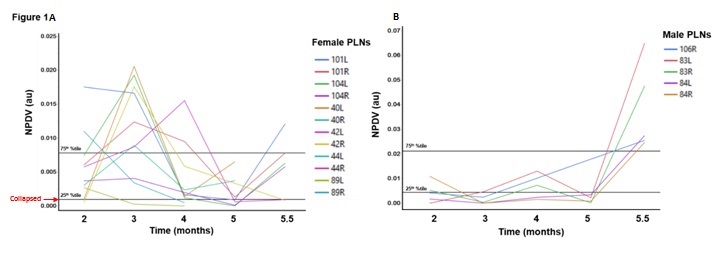Session Information
Session Type: ACR Poster Session A
Session Time: 9:00AM-11:00AM
Background/Purpose: Although rheumatoid arthritis (RA) tends to occur earlier and with increased severity in females, the underling etiology of this sexual dimorphism is unknown. We have investigated the behavior of draining lymph nodes in murine models of inflammatory-erosive arthritis as a potential translational biomarker of arthritic initiation and flare. We have shown in tumor necrosis factor-transgenic (TNF-Tg) mice that ankle arthritis commences with enlargement of the popliteal lymph node (PLN) that continues to expand until the volume suddenly and stochastically collapses, coinciding with arthritic flare in the ipsilateral knee. To assess if this biomarker of disease onset and progression recapitulates the sexual dimorphism observed in clinical RA, we performed a longitudinal power Doppler ultrasound (PD-US) study of PLN in male and female TNF-Tg mice.
Methods: PD-US was performed on the PLN and knee of each leg in male (n=3 mice; 5 PLN/knees) and female (n=6 mice; 12 PLN/knees) TNF-Tg mice at 2, 3, 4, 5, and 5.5 months of age. PLNs were phenotyped as expanding if the normalized PD (NPDV) signal exceeded the 75th percentile, or collapsed if it dropped below the 25th percentile after an expanding classification, as previously described (1). Each PLN/knee was evaluated independently, and percentiles were computed for each sex separately. The frequencies of expanded or collapsed PLN over time were compared using Fisher’s exact test; and knee NPDV comparisons used RM-ANOVA.
Results: There were more expanded nodes at 3 months in female TNF-Tg mice (Figure 1a) compared to males (Figure 1b) (6 vs 0, p<0.01), but at 5.5-months, male animals had significantly more expanding nodes (5 vs 0, p<0.01). The transition to collapsed nodes occurred in 5 females during the study period compared to 0 collapsed in males. Even more strikingly, all of the females with collapsed nodes before 4 months of age died before the final 5.5 month time point. There were no significant differences between sexes in knee NPDV at any time point, however both female and male displayed significantly increased NPDV at 5.5 vs. 5 months of age (0.19 ± 0.10, 0.24±0.04 vs 0.04 ± 0.04, 0.11 ± 0.10, p<0.05).
Conclusion: This is the first demonstration that PLN collapse occurs earlier in female TNF-Tg mice. Interestingly, knee NPDV increases, indicative of inflammatory-erosive arthritis, occur at the same time in both sexes. Taken together, this data supports the hypothesis that the mechanisms of RA are sex dependent, confirming this animal model as representative of the sexual dimorphism seen in patients. Further work is needed to elucidate the mechanism for early PLN collapse and mortality of female TNF-Tg mice. 1. Bouta EM, Ju Y, Rahimi H, de Mesy-Bentley KL, Wood RW, Xing L, et al. Power Doppler Ultrasound Phenotyping of Expanding versus Collapsed Popliteal Lymph Nodes in Murine Inflammatory Arthritis. PLoS One. 2013;8(9):e73766.
To cite this abstract in AMA style:
Wu E, Bell R, Rudmann C, Wood R, Ritchlin CT, Rahimi H, Schwarz E. Sexual Dimorphism of Popliteal Lymph Node Collapse As a Biomarker of Disease Progression in the Tumor Necrosis Factor Transgenic Mouse Model of Rheumatoid Arthritis [abstract]. Arthritis Rheumatol. 2016; 68 (suppl 10). https://acrabstracts.org/abstract/sexual-dimorphism-of-popliteal-lymph-node-collapse-as-a-biomarker-of-disease-progression-in-the-tumor-necrosis-factor-transgenic-mouse-model-of-rheumatoid-arthritis/. Accessed .« Back to 2016 ACR/ARHP Annual Meeting
ACR Meeting Abstracts - https://acrabstracts.org/abstract/sexual-dimorphism-of-popliteal-lymph-node-collapse-as-a-biomarker-of-disease-progression-in-the-tumor-necrosis-factor-transgenic-mouse-model-of-rheumatoid-arthritis/

